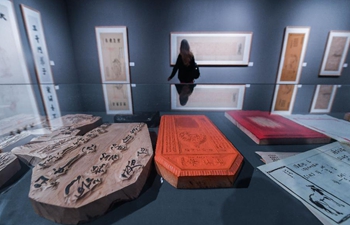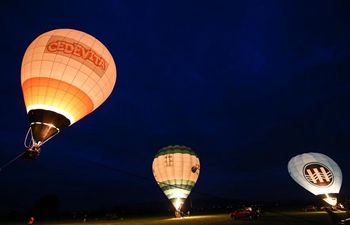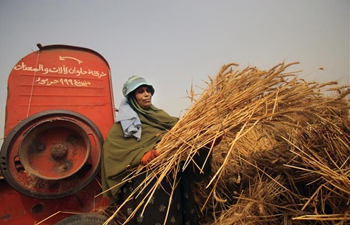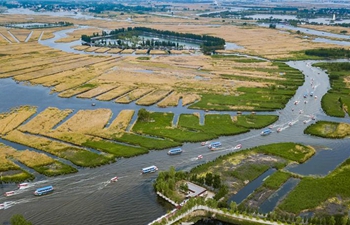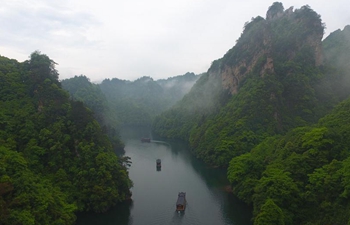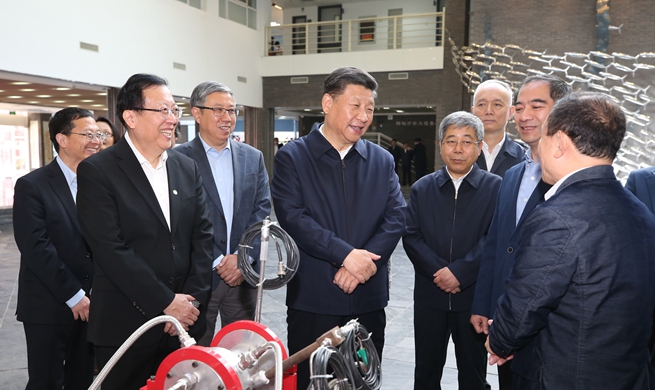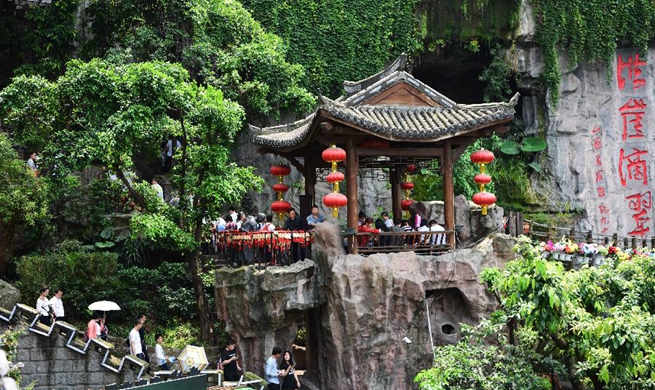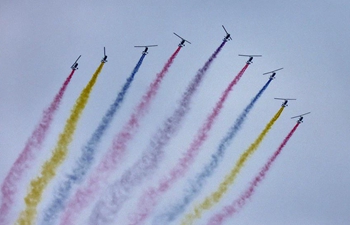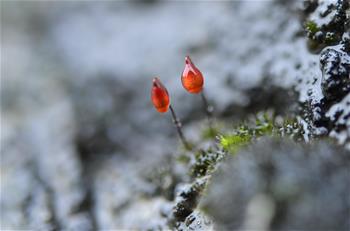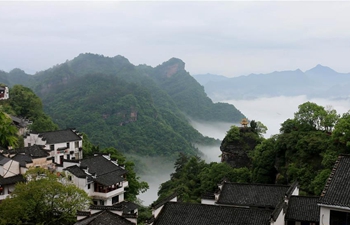By Sportswriter Liu Yang
FUZHOU, May 2 (Xinhua) -- Like many other Chinese born in the 1960s, a figure skater surnamed Bao has the popular given name of Zhenhua, literally meaning to revitalize China.
She was lucky enough to witness the historic moment of China's debut at the Winter Olympics 38 years ago, and what's more, the 14-year-old girl was a part of that history.
WINTER OLYMPICS DEBUT
The Chinese Olympic Committee (COC) sent a delegation in February 1980 to participate the 13th Winter Olympic Games in Lake Placid, the United States, a few months after the COC was restored as the lawful chair of the International Olympic Committee (IOC).
This was a huge step for Chinese winter sports athletes, and Bao was among the delegation. She was not regarded as the best on singles' performance, but the youngest girl, with the shining smile, seemed to be the most appropriate one to represent the rejuvenating nation after China launched its national reform and opening up strategy in 1978.
Bao had never competed in any international games before the 1980 Olympics.
"Everything came in a sudden," recalled Bao, "jumping to the Olympics sounded so sweet to me. I don't know how to describe my feelings, nervous, excited, curious, and overcautious, it's so complicated."
Bao joked that she almost forgot her moves after she saw the foreign skaters' training.
"My mind was blown out. They were so good and I never saw those moves before," said Bao, "the disco music was very popular around the world in 1980s. I was stirred to see the foreign athletes dance to the rhyme."
The most impressive thing at Lake Placid was a TV interview, talking to the American legendary figure skater Peggy Gail Fleming, the 1968 Olympic champion in ladies' singles.
"Peggy was the commentator with ABC. She asked me what I would do after the Olympics and I said I'd definitely skate all my life," said Bao.
Bao ranked at the bottom among all the competitors after free skating, short program and prescribed movements. The tour of Lake Placid showed how large the gap was between China and the strong teams. No one out of the total 28 athletes advanced to top 6.
TOUGH TRAINING ON TOUGH ICE
Born into a skiing family in Northeast China's Jilin Province, Bao had been familiar with many winter sports since childhood. But as a young girl, she couldn't tell the difference between the figure skates and speed skates.
"I just knew I needed to learn dancing in figure skating and the girls always love beautiful things, so I just picked up wearing figure skates," said Bao, "there were not big brands to choose when I was an abecedarian, the skates are hand-made by my coach who also took to mending the skates, which were easily broken at outdoor rinks."
In the late 1970s, there were no indoor skating rinks around China. The athletes were training outdoors during the winter time.
"We poured down the water onto the playground at school, and that was the rink when the water froze," said Bao, "you can imagine how tough the ice was."
Keeping warm is another serious problem for young skaters who practice outdoors.
"The training pictures in 1970s look funny nowadays," Bao laughed, "we wore too much to make moves on ice, but we felt so cold if we did not wear enough. We could even hardly unbuckle our pants in the toilet; our hands were numb."
Progressing all the way from Jilin to the national team, Bao flew quickly to the Olympics. Before she was recruited to the training camp in Japan for Lake Placid, Bao had never skated on indoor ice.
Bao's first skating dress, hand-made by her coach Miao Ruifu using dacron fabrics, was inelastic and inconvenient for jumping, spinning and splitting.
Miao contacted many textile mills to customize a nylon dress for Bao. In addition, Miao was also in charge of choreography, music clips, and even the skaters' daily life, in addition to playing the role of mentor and tutor.
SKATING BRINGS NO VICTORY, BUT LOVE FOR THE SPORT
Coming back from the Lake Placid, Bao was determined to skate above 15 in the ladies' singles in the next Olympics.
"The following four years were the most difficult period of my life," said Bao, "and the most frustrating period as well. Me and my coach, we worked so hard to get better results."
She flew to the United States and Germany for better training conditions in 1981, but was injured right before the World Junior Figure Skating Championships in 1982.
Like most of the athletes, she fought against the biggest enemy: her own body. She began to challenge herself to complete more difficult jumps and spins without any protection measures. With hundreds of falls and tumbles, she never gave up the dream of competing in her second Olympics.
At 1984 Sarajevo winter Olympics, Bao fell and ranked 19th. Feeling heartbroken and disappointed, Bao decided to retire.
Skating did not bring her success, but it did pair her with a beloved lifetime partner in Bian Shaotang, who has served for 10 years as the captain of China's national ice-hockey team.
Bian's team fought to Group B in the 1981 World Championships, and ranked 15th in the 1982 championships, maintaining that record even now. Bian was also honored as the best guard in Group B in 1982.
They got married after retiring from the national teams, and winter sports have always stayed in their lives.
TORCH RELAY FOR THE RISING STAR
Bao and his husband moved to Japan for a college education in the 1990s but they always kept their eyes on Chinese figure skating.
She and her family drove some 10 hours from Kyushu to Nagano to cheer for the Chinese rising figure skater Chen Lu at 1998 Winter Olympic Games in Japan. Chen, coming from Jilin Province as well, won a bronze in ladies' singles.
When the famous pair Shen Xue/Zhao Hongbo were crowned with the gold at the 2010 Vancouver Winter Olympics in Canada, Bao jumped up from couch for joy in front of TV.
"That was another historic moment for Chinese figure skating," said Bao, "we've been waiting for this outcome for 30 years!"
After Beijing and Zhangjiakou jointly won their bid for the 2022 winter Olympics, Bao witnessed huge changes in Chinese winter sports. Many indoor rinks have been built around the nation, especially in the warm areas of Southern China.
The southerners are apparently more curious about skating, since they did not have much of a chance to try this in the past. The training market has been growing rapidly and it is in great need of good coaches.
Bao, together with Bian, came back to her motherland and devoted themselves to the development of Chinese winter sports in the new era. Bao has been coaching kids at a training agency in Southeast China's Fuzhou city for one year and she is impressed by people's enthusiasm for skating.
There had been no indoor rinks in Fuzhou until 2016, when two rinks were built inside shopping malls.
"Skating is a special experience for the southerners, many people come to try and learn at weekends and holidays," said Bao. "Sometimes there were too many skaters at a time, and the rink seems too small and the number of skates for rent is far from enough."
"The southerners, generally speaking, are not as tall and strong as the northerners, but they can be more skillful. Maybe it's a kind of advantage in figure skating that we had not discovered before," laughed Bao.




